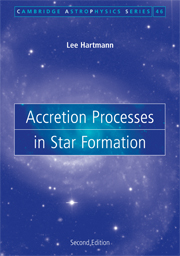Book contents
- Frontmatter
- Contents
- Preface to the first edition
- Preface to the second edition
- Acknowledgments
- 1 Overview
- 2 Beginnings: molecular clouds
- 3 Initial conditions for protostellar collapse
- 4 Protostellar cloud collapse
- 5 Protostellar collapse: observations vs. theory
- 6 Binaries, clusters, and the IMF
- 7 Disk accretion
- 8 The disks of pre-main-sequence stars
- 9 The FU Orionis objects
- 10 Disk winds, jets, and magnetospheric accretion
- 11 Disk accretion and early stellar evolution
- 12 Disk evolution and planet formation
- Appendix 1 Basic hydrodynamic and MHD equations
- Appendix 2 Jeans masses and fragmentation
- Appendix 3 Basic radiative transfer
- List of symbols
- Bibliography
- Index
6 - Binaries, clusters, and the IMF
Published online by Cambridge University Press: 30 October 2009
- Frontmatter
- Contents
- Preface to the first edition
- Preface to the second edition
- Acknowledgments
- 1 Overview
- 2 Beginnings: molecular clouds
- 3 Initial conditions for protostellar collapse
- 4 Protostellar cloud collapse
- 5 Protostellar collapse: observations vs. theory
- 6 Binaries, clusters, and the IMF
- 7 Disk accretion
- 8 The disks of pre-main-sequence stars
- 9 The FU Orionis objects
- 10 Disk winds, jets, and magnetospheric accretion
- 11 Disk accretion and early stellar evolution
- 12 Disk evolution and planet formation
- Appendix 1 Basic hydrodynamic and MHD equations
- Appendix 2 Jeans masses and fragmentation
- Appendix 3 Basic radiative transfer
- List of symbols
- Bibliography
- Index
Summary
Virtually all stars are born with neighbors. Most stellar systems are multiple, and many if not most stars are born in groups, with a subset in clusters of substantial numbers of stars. An understanding of multiplicity is therefore an important part of theories of star formation.
The complex structure within molecular clouds, and in particular the asymmetries present in protostellar cores, may be essential to understanding the process of forming binaries. Whether the disks formed during protostellar collapse are capable of spawning multiple stellar companions rather than simply accreting onto the central object is an open question, perhaps requiring strong departures from axisymmetry in the infalling material. Observationally, we detect multiple protostellar systems which appear to lie within disks or toroids in Class I sources, indicating that stellar fragmentation occurs before infall to the disk is complete.
The early evolution of binary and multiple stellar systems is likely to be complex. The growth in mass of fragments formed early on will depend upon complicated accretion processes in disks and infalling envelopes. If more than two fragments are formed, the system can become dynamically unstable, resulting in dispersal or ejection of some members. Whether many or even any stars are initially formed as single objects, or instead were ejected from multiple systems, is currently unclear.
Probably most young stars are born in clusters or groups. Currently most stars in the solar neigborhood are born in modest-sized groups of order 10–100 members in regions of order a pc in size.
- Type
- Chapter
- Information
- Accretion Processes in Star Formation , pp. 112 - 128Publisher: Cambridge University PressPrint publication year: 2008



